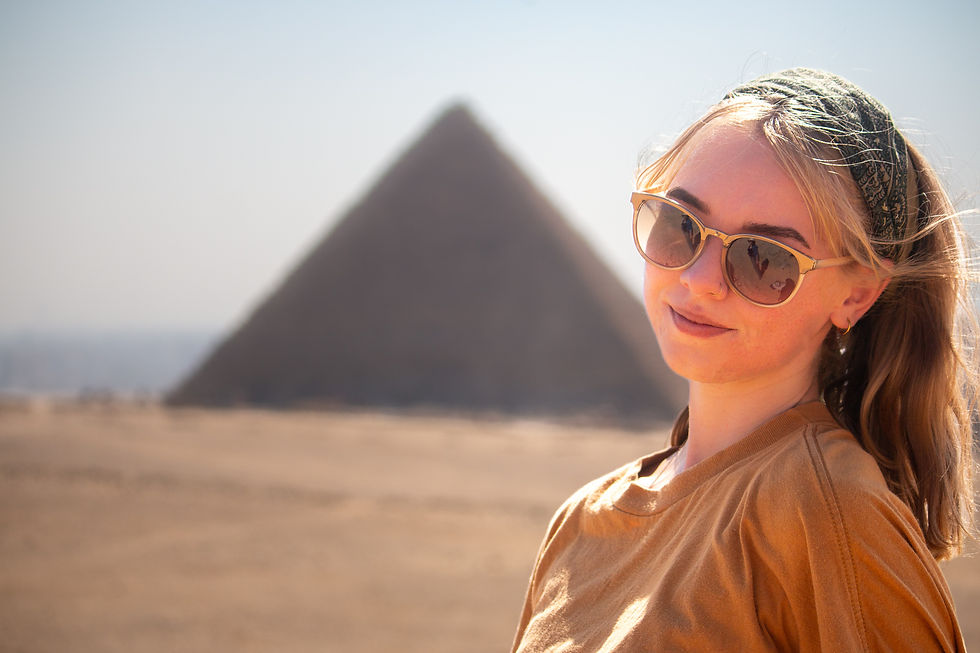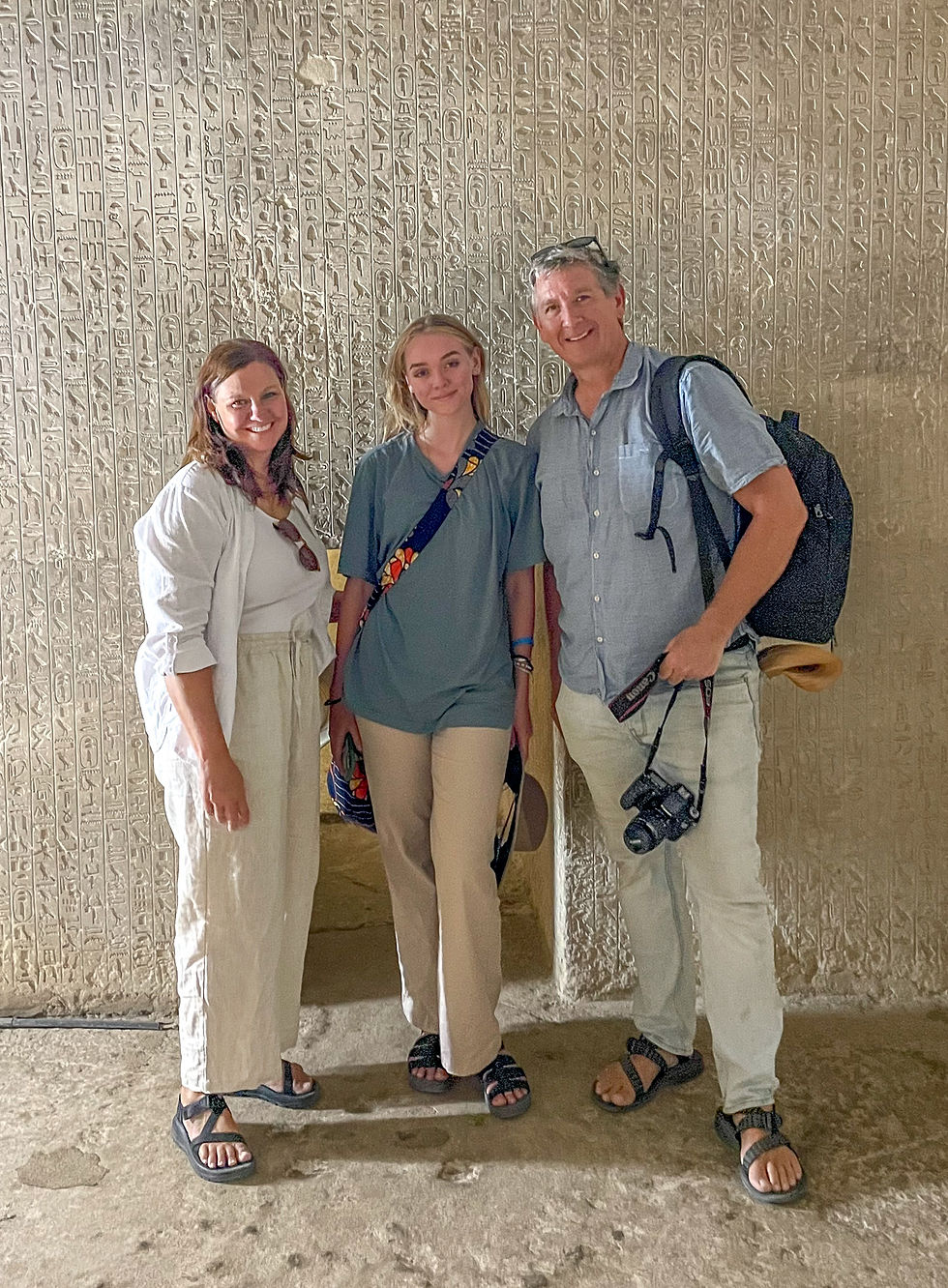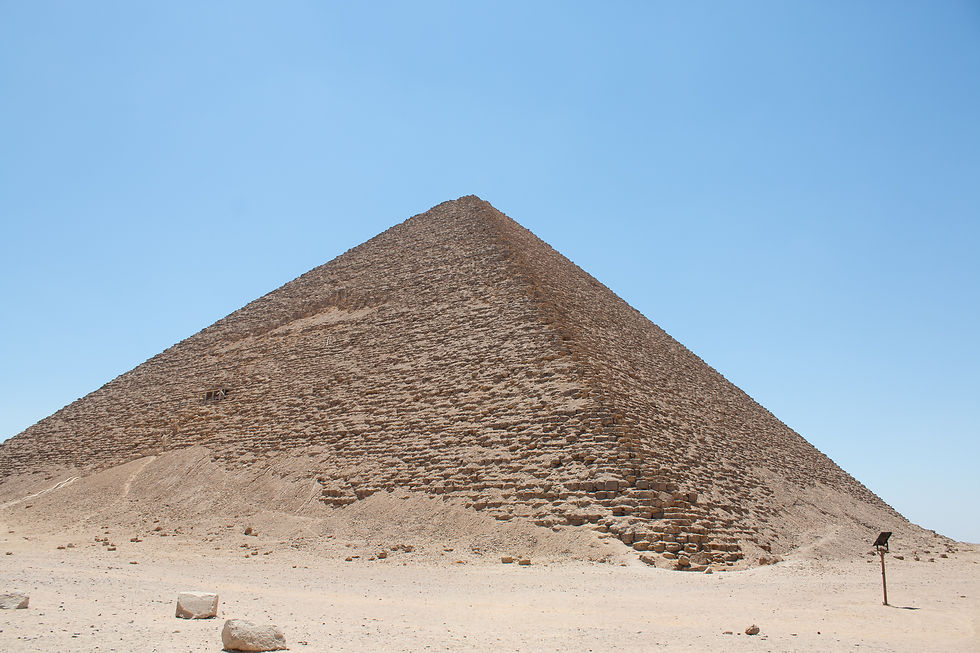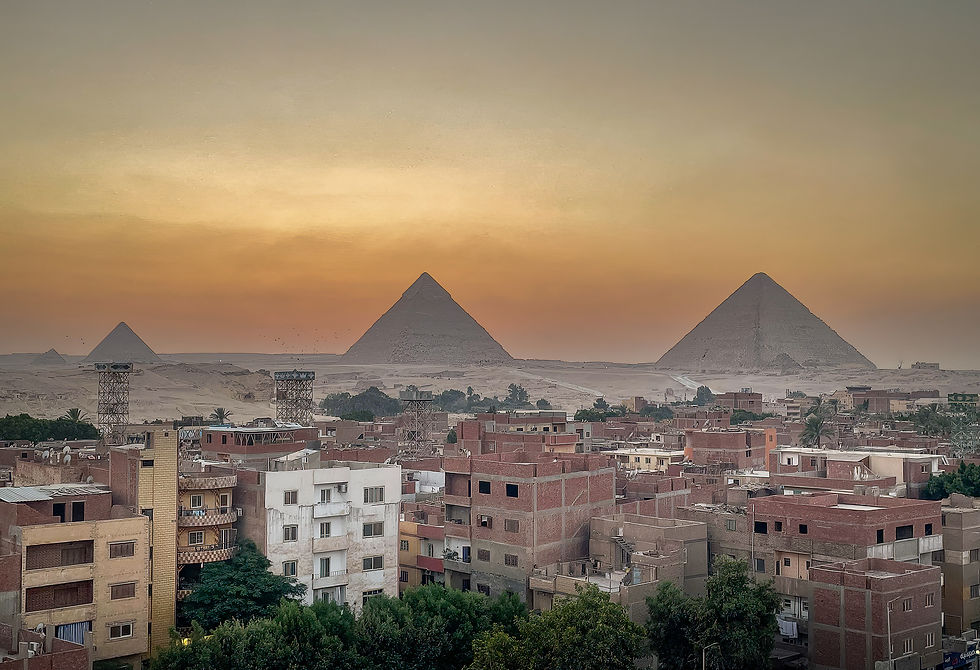Dust, Awe, and a Rooftop Pizza Hut: Tips for Visiting the Pyramids of Egypt
- Rand Blimes

- Jun 4, 2025
- 10 min read

20-year-olds are weird.
I know this because my daughter was 20 when she looked at me, a sparkle of chaotic adventure in her eye, and said:
“I wonder—through all of history—how many people have licked a pyramid?”
And with that, we stepped up to the Great Pyramid of Khufu and... I hate to admit this... we licked it.
Now, on one hand, I’m probably the only person you know who’s done this. And that kind of uniqueness is hard to come by.

On the other hand, I’m probably just lucky I didn’t contract some long-dormant pharaonic strain of hepatitis. Let’s call it Hep-P.
Just be warned: travel with the young and ridiculous-without-a-cause is thrilling, strange, and potentially biohazardous.
Proceed accordingly.
Alright, let’s talk about pyramids
NOTE: you can find prices to enter the various pyramids updated to 2025 here.
Tips for Visiting the Pyramids—Not Just Giza
Say the word pyramid, and most people picture a single place: Giza. The three iconic silhouettes, dusted in golden light, fronted by the ever-loyal Sphinx. And yes—those pyramids are magnificent. But if that’s all you know of ancient Egypt’s pyramid legacy, you’re missing the first half of the story.
Egypt’s pyramid-building began long before the perfection we see at Giza. The earliest attempts, starting around 2700 BCE, were less about grandeur and more about trial and error. At Saqqara, the Step Pyramid of Djoser, built for one of Egypt’s earliest pharaohs, marks the world’s first large-scale stone structure. From there, builders experimented—with slope, shape, and technique. South at Dahshur, the Bent Pyramid shows a mid-project shift in the angle of the walls half way up the sides. Nearby, the Red Pyramid reflects a lesson learned: a gentler slope, a more stable base, and the first truly "smooth-sided" pyramid.
By the time the Great Pyramid of Khufu (Cheops) rose at Giza around 2560 BCE, engineers had ironed out many of the bugs. What you see there is the polished result of generations of architectural evolution.
And that’s exactly why I’d suggest this: visit the older pyramids first. Start at Saqqara and Dahshur. Watch the pyramid shape evolve before your eyes. Get the place nearly to yourself. And yes, you might even find yourself clambering through a dark, narrow tunnel into the very heart of a 4,500-year-old tomb—completely alone.
Then visit the classic trio at Giza.

For a list of fees for Egypts monuments updated through 2025, see here.
Planning a Pre-Giza Day: Saqqara, Dahshur, and Memphis
If you're serious about pyramids—and let's face it, if you're in Egypt, you probably should be—then don’t start at Giza. Start earlier. Literally.
It’s easy to hire a car and driver for a day trip out to the desert plateaus south of Cairo, where you’ll find some of the oldest pyramids in the world. You can even add an Egyptologist guide to your ride—someone who actually studied this stuff (and who will, yes, be Egyptian) and can walk you through the evolution of ancient architecture with the passion of a true believer. Or at least a true nerd (my kind of person!).
This is a trip that’s easiest to organize from Giza rather than Cairo. Yes, you can do it from Cairo, but fair warning: the traffic between Cairo and Giza can be brutal. If you really want to dive into pyramid country without spending half your day stuck in a car, plan to base yourself in Giza for a few nights. Trust me—it’s worth it.
Next, we’ll break down each site so you know what to expect and what not to miss.

Saqqara: Where the Pyramid Story Begins
Many people think the pyramids in Giza were the first. They weren't. That honor belongs to Saqqara, just south of Cairo, where the world’s very first pyramid still rises in grand, blocky steps above the desert floor.
This is the Step Pyramid of Djoser, built more than 4,600 years ago during Egypt’s 3rd Dynasty. Designed by Imhotep—the ancient world’s first named architect—it was a revolutionary leap forward in monument building. Before this, Egyptian tombs were simple, flat-roofed structures called mastabas. Imhotep just decided to stack a few mastabas on top of each other and, voilà, the pyramid was born.

The site around the Step Pyramid is an archaeological goldmine. You’ll see ancient tombs carved into the bedrock, the partially reconstructed colonnade entrance to Djoser’s mortuary complex (a wonder in itself), and massive limestone walls enclosing the sacred space. And there’s a sense of calm out here that Giza just can’t match.
This is also where you start to feel how pyramid building evolved—from layered stone blocks to smooth, geometric perfection. It’s like watching human ambition slowly refine its technique over centuries, one sandstone slab at a time.
If you have the time and energy, make a quick stop at the Imhotep Museum, located near the entrance to the Saqqara complex. It’s small but well-curated, and offers a welcome bit of air conditioning. One of the real highlights is the statue of Pharaoh Djoser, the oldest known life-sized Egyptian royal statue. It’s a perfect final stop to bring the history of Saqqara full circle.

Dahshur: Trial and Triumph in Stone
A bit further south you will come to Dahshur, with its two interesting and important pyramids, both built by the first pharaoh of the fourth dynasty, Sneferu.

First up is the Bent Pyramid, named for its curious shape. Halfway up, the sides suddenly change angle, giving the whole structure a gently slumped look—like it started standing tall, then changed its mind. The current theory? Builders may have realized the original angle was too steep to be stable and adjusted mid-construction to avoid catastrophic collapse. Sneferu didn’t abandon it—he finished it, and remarkably, it still stands, complete with some of its original polished limestone casing.
If you only venture inside one pyramid, make it the Bent Pyramid. Just be warned: this is not a journey for the claustrophobic or grossly out of shape. The interior passage is narrow, steep, and decidedly not ergonomic. After descending a sharp flight of stairs into the pyramid (because in Egypt, you always descend into a tomb), you then claw back that elevation with another staircase deeper in. And then, for me, came the best part: solitude.

My wife didn’t enter the pyramid at all (claustrophobic), and my daughter didn’t want to tackle the second set of stairs (wimp!). So I was completely alone. I duck-walked and crawled through a narrow passage, softly humming the Indiana Jones theme for moral support, and emerged into the burial chamber—just me, and history, and maybe a bat or two hanging above me. Perhaps even a ghost. Definitely no tourists. Just silence, and the strange comfort of being absolutely deep within the ancient stone.
Next up: the Red Pyramid, Sneferu’s redemption arc...
Using the lessons from his previous miscalculation, this one was built with a shallower, more stable slope. It’s Egypt’s first successfully completed “true” pyramid—and for those who make the trip, it might also be the most enjoyable.
Why? Because it is beautiful, classically shaped, and almost as empty as the Bent Pyramid. You can climb the steep steps to a narrow entrance and duck-walk your way down a long, claustrophobic tunnel into the heart of the structure. It isn’t quite as robust as the Bent Pyramid, but it still feels a touch adventurous.

Dahshur doesn’t get the crowds. But it does have the quiet dignity of a place where builders learned, adapted, and laid the final blueprint for one of history’s greatest architectural feats. It’s less polished than Giza, and all the better for it.
If you want to understand pyramids, you can’t skip Dahshur. This is where failure and triumph were carved from the same limestone—and where the pyramids first found their perfect shape.
A Side Quest to Memphis: Ramesses, Reclaimed
While not home to any pyramids, Memphis, situated between Saqqara and Dahshur, makes for a worthy final stop on your day trip out of Giza or Cairo. As the ancient capital of Egypt during the Old Kingdom, Memphis once stood as the seat of power for pharaohs whose burial monuments now dot the nearby deserts. Today, what remains is modest—but memorable.
The main attraction is the open-air museum, where you'll find a colossal statue of Ramesses II lying on its back in a specially constructed building. Even in repose, the craftsmanship and scale are awe-inspiring. There are also sphinxes, fragments of statuary, and assorted ruins that hint at the grandeur that once was.

If you’re doing Saqqara, Dashur, and Memphis all in one day (which is absolutely doable), I recommend visiting them in that order: start with the Step Pyramid at Saqqara, move on to the experimental forms at Dashur, and end the day in Memphis with a more personal encounter with one of Egypt’s most iconic rulers. It’s a full day of exploring the evolution of Egypt’s earliest ambitions in stone.

And if you want the perfect capstone to your perfect pyramid day, here’s the move: when you get back from your day-trip to the south, grab a quick nap and shower the ancient dust off yourself (or keep it—maybe you’re starting a collection, no judgment). Then head out for dinner at… wait for it… Pizza Hut.
Yes, really.
There is a Pizza Hut directly across the street from the Pyramids of Giza. Order a stuffed crust pizza or some garlic breadsticks at the counter, head to the rooftop seating, and settle in to watch the sun set behind the pyramids.
And then, stay for the cheesiest light show this side of the 1970s. I wouldn’t necessarily recommend buying a ticket for the light show that takes place every evening on the Giza Plateau—but from the rooftop of the Pizza Hut, with carbs and kitsch in hand? Absolutely priceless.

The Pyramids of Giza (Giza Necropolis)
Let’s clear up one common misconception right away: the pyramids of Giza do not rise in perfect isolation from a sea of desert sand. When you stand on one side, yes, it’s dunes and open horizon. But turn around and—boom—there’s the city of Giza right at your back. Urban sprawl butts right up against the edge of the ancient necropolis, complete with honking horns, apartment blocks, and (happily) the occasional falafel stand.

This contrast doesn’t make the pyramids any less majestic. But it’s good to know what you’re walking into. And speaking of walking: don’t expect to do it all on foot. The site is far too large and spread out. You’ll need a driver at minimum—ideally one familiar with the layout who can shuttle you from spot to spot. You can add a guide (an actual Egyptologist, if you want to splash out), but it’s not required. We recommend asking your hotel for recommendations. Most hotels have someone they work with regularly, and you’re likely to get a better rate than if you try to book online.
That said, make sure your hotel knows what they’re talking about. Ours (Sahara Pyramids Inn—avoid it!) insisted the pyramids didn’t open until 9am. We politely pushed back, telling them we’d found 7am listed in multiple places. They doubled down: 9am, they said. We ended up compromising and asked for a driver to pick us up at 8. But sure enough, when we arrived, the pyramids had already been open for over an hour. We missed the soft early light, the best photography conditions, and the wonderfully thin crowds. Whether our hotel was simply misinformed or trying to game something on the backend, I’ll never know. But the lesson is this: double-check the opening hours (they were 7am when we went), and trust your research.

Once you're in the Giza complex, you’ll explore by car, hopping from viewpoint to viewpoint. There are three main pyramids (Khufu, Khafre, and Menkaure), plus mortuary temples, smaller queen pyramids, and the Great Sphinx. If you didn’t go inside the pyramids at Dahshur, you might consider going into one of these. But if you did brave the tunnels of the Bent or Red Pyramids, well… those experiences are better. And less crowded. The interiors at Giza are tighter, hotter, and pricier. It’s worth considering whether you want to add them just for the experience—or whether it’s better to admire the Giza pyramids from outside, in all their world-wonder glory.

At Giza, it’s not about solitude—it’s about scale. These are the pyramids people dream of, the ones kids sketch in the margins of their notebooks, the ones you see in movies and documentaries and pop culture references everywhere. There’s a reason for that. They’re breathtaking.
Just be prepared for crowds, touts, camel ride offers, and the ever-present question: “Where you from, my friend?”
And another word of advice: don’t lick the pyramids. Because you might just contract Hep-P. And my family likes being the only people we know who have licked a pyramid.
So yes—plan your pyramid days. See Saqqara and Dashur first if you can, then let Giza take your breath away with sheer scale. Go inside a pyramid. Or don’t. Ride a camel if you want. Or maybe just eat pizza and watch the sun set over 4,500 years of human ambition. And somewhere in all that dust and wonder, the heat and hassle, you’ll feel it too—that odd little spark that comes from brushing up against the impossible weight of history. It lingers in your clothes and clings to your thoughts long after you leave. That’s what it means to stand in the shadow of the pyramids. That’s what it means to feel the world, not just see it. Because pyramids.



Comments